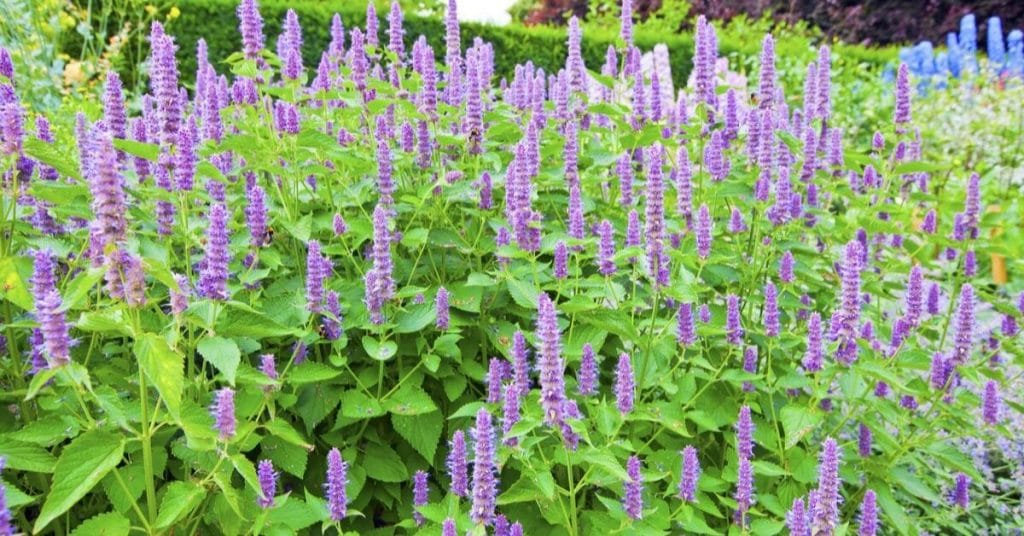Anise Hyssop is a member of the mint family, although the plant smells like anise, hence the name. It is found normally distributed in North America, although other areas can cultivate the plant. It is often used as a medicinal plant by Native American populations.
Anise Hyssop Facts
The plant known as Anise Hyssop is also known by its scientific name, Agastache foeniculum. The plant’s genus name comes from the Greek “agan” which means “very much,” and the Greek word “stachys,” which means an “ear of wheat.”
The name references the flower spikes that Anise Hyssop has. Other common names for Anise Hyssop include the blue giant hyssop and lavender giant hyssop.
History of the Agastache Foeniculum
There is little recorded history of Anise Hyssop. Medicinal uses of the plant have been recorded by Native Americans.
For example, the Chippewa use a mixture of Anise Hyssop with Elk Mint as a remedy for problems such as colds and chest pain. These properties are a result of the plant containing numerous essential oils.

What Does Anise Hyssop Flower Look Like?
Anise Hyssop grows on to be roughly two to four feet tall in the wild and when cultivated. During mid- to late summer, the plant has blooms of purple to lavender flowers located on the terminal ends of spikes.
The area of the flower has many blooms that are packed into cylindrical terminal flower spikes that are roughly three to six inches long.
The plant has square stems that have ovoid leaves that are dull green in color and up to four inches long. The edges of the leaves have toothed margins. The leaves are anise-scented, while the flowers have no real scent. That said, the flowers attract a variety of pollinators, including bees and butterflies.
Varieties
There are 22 species of plants that fall within the Agastache genus. These largely go by the name of giant hyssops or hummingbird mints. Relatives of this genus include the true hyssops. Anise Hyssop, despite the name, is not a true hyssop or an anise plant.
Growing Season and Region
Anise Hyssop is native to Northern regions of North America, including states such as Wisconsin, Delaware, and Connecticut. It can also be found in areas of Canada, such as British Columbia. The native distribution is Northern Colorado to Wisconsin and north to the adjacent areas of Canada.
Anise Hyssop grows throughout the spring and summer, but it does not bloom until mid- to late summer. The general flowering season is from June through September. You can encourage the plant to have additional blooms by deadheading flowers that have already been spent.

Planting
When you plant Anise Hyssop, will be best grown in average soils that have dry to medium moisture. These are plants that don’t appreciate over-watering, especially when they have established root systems.
As such, the soils should be well-drained. They tolerate areas ranging from full sun to partial shade, but they really like being fully in the sun.
Once you have established a growth of Anise Hyssop, it will spread by rhizomes, so you may want to plant it in pots if you don’t want it to spread. The plants will also generally self-seed pretty easily if the conditions are kept optimum.
Fun Facts About the Anise Hyssop
Anise Hyssop tends to be a pretty hardy plant and isn’t affected by many diseases. That said, if the plants are kept too moist, they may develop issues such as crown or root rot. They can also develop issues such as leaf spots and powdery mildew.
The plant can be used as a seasoning, and fresh flowers can be eaten in salads. Dried leaves can be brewed into teas.
Up Next: Anise Hyssop Flower Meaning and Symbolism
References
Moerman D. 1991. The medicinal flora of native North America: an analysis. Journal of Ethnopharmacology https://www.ncbi.nlm.nih.gov/pubmed/2030588
Facciola S. Cornucopia II: A Source Book of Edible Plants. Kampong Publishing, Vista, 1998.
Close
Credit: Photo by Debu55y/depositphotos.com & saiberiac&nhq9801/flickr.com







